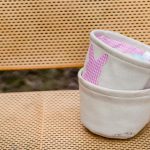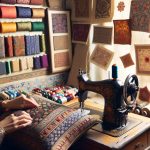When you think about enhancing your home decor with advanced sewing methods, the opportunities are limitless. Picture turning a basic fabric into a masterpiece through detailed embroidery, precise quilting, or personalized piping. Every approach provides a distinct way to enhance your area, whether it's through top-notch pleating or ornamental appliqué. The crucial part is mastering these methods to guarantee your creations appear expertly crafted. But how do you attain that ideal harmony between innovation and accuracy? Let's delve into some suggestions and techniques that will assist you in transforming your sewing projects into striking pieces for your home.
Table of Contents
Key Takeaways
- Master intricate stitching and detailed designs using high-quality fabrics and threads.
- Ensure precise seam alignment and pattern consistency in quilting with high-quality measuring tools.
- Create dynamic looks with varied pleating and folding techniques, focusing on measurement and pressing accuracy.
- Experiment with bold and custom piping, using fabric strips cut on the bias for precision.
- Combine colors, patterns, and textures in decorative appliqué to create unique focal points.
Intricate Embroidery
When you want to add a touch of elegance to your home decor, intricate needlework can transform even the simplest fabric into a stunning piece. By mastering detailed stitching and elaborate designs, you can turn ordinary cushions, curtains, or tablecloths into extraordinary works of art.
Start by selecting the right materials. High-quality fabric and thread choices are essential for achieving those crisp, clean lines and rich textures that make embroidery enthralling.
Focus on learning a variety of embellishment techniques. Satin stitch, French knots, and bullion knots are just a few methods that can bring your designs to life. Each stitch type offers a unique texture and visual impact, allowing you to create depth and dimension in your work.
Pay close attention to your thread choices, as the type and color of thread can dramatically alter the final appearance. Opt for silk or cotton threads for a luxurious finish, and experiment with metallic or variegated threads for added flair.
Precision Quilting
When it comes to precision quilting, you'll need to focus on accurate measuring techniques, seam alignment, and maintaining pattern consistency.
Start by ensuring your measurements are exact to avoid any mismatches.
Next, align your seams carefully and use strategies to keep your patterns uniform throughout the quilt.
Accurate Measuring Techniques
To achieve accurate quilting, start by using high-quality measuring tools for precise measurements. A reliable ruler, measuring tape, and a cutting mat are essential. These tools ensure that your fabric manipulation is exact, which is essential for sewing accuracy.
First, always press your fabric before measuring. Wrinkles and folds can distort measurements, leading to errors. Use a clear ruler to mark your lines, and double-check your measurements before cutting. This step is important in avoiding mistakes that could affect your quilting project.
Next, focus on advanced hemming techniques. When you fold the fabric for hems, make sure the measurements are consistent along the entire edge. Use pins or fabric clips to hold the fold in place before stitching.
For precise stitching, maintain a steady hand and a consistent speed on your sewing machine. Using a walking foot can also help keep layers of fabric from shifting.
Seam Alignment Tips
Proper seam alignment is necessary for achieving a polished and professional look in your quilting projects. Start by carefully selecting your fabric; the right fabric selection can greatly impact how well your seams align. Opt for high-quality fabrics that don't stretch excessively and cut precisely to maintain consistency.
Before you begin sewing, measure your seam allowances meticulously. Consistent seam allowance measurements are vital for accurate alignment. Use a ruler or seam gauge to guarantee each seam is the same width. This uniformity helps prevent any misalignment as you piece your quilt together.
Pressing is another key aspect. After sewing each seam, press it flat using an iron. Pressing, rather than ironing, ensures that the fabric remains smooth and the seams stay crisp.
Always press your seams in the direction indicated by your pattern or towards the darker fabric to prevent shadowing.
Pattern Consistency Strategies
Achieving pattern consistency in precision quilting involves meticulous attention to detail and a few strategic techniques. First, you need to focus on consistent pattern matching. Lay out your fabric and guarantee that the patterns align perfectly before cutting. Pin or baste them in place to avoid any shifting during the sewing process.
Next, consider the importance of pattern alteration techniques. Sometimes, your fabric's design mightn't align perfectly due to irregularities. In such cases, slightly adjust the pattern pieces before cutting to guarantee a harmonious overall look. This might involve trimming or extending certain sections, but the result will be a seamless, professional finish.
Furthermore, use a ruler and rotary cutter for sharp, precise cuts. Always measure twice and cut once. Mark your fabric with a chalk pen to guide your stitches and guarantee perfect alignment.
When sewing, maintain a steady pace and consistent stitch length to avoid any distortions in the pattern.
Expert-Level Pleating
When tackling expert-level pleating, you'll first need to understand the different types of pleats and their unique applications.
Precision in measuring and marking is vital to achieving professional results.
Types of Pleats
Mastering the art of pleating adds an elegant touch to your home decor projects, elevating them from simple to sophisticated. Understanding pleat variations and fabric manipulation is pivotal for achieving the desired look. Box pleats, knife pleats, and accordion pleats each offer unique aesthetics and functionalities. By mastering these variations, you can control how the fabric falls, ensuring it complements your drapery design.
Pleat placement is another vital aspect. For instance, in drapery design, you might place pinch pleats at regular intervals to create a tailored, formal look. Alternatively, spaced pleats can give a more relaxed, contemporary vibe. The placement affects not only the appearance but also the way the fabric hangs and moves.
Here's a quick reference table to help you understand the different pleat types:
| Pleat Type | Characteristics | Best Used For |
|---|---|---|
| Box Pleat | Deep, evenly spaced folds | Curtains, valances |
| Knife Pleat | Sharp, narrow folds | Bed skirts, table skirts |
| Accordion Pleat | Series of small, uniform pleats | Lampshades, sheer curtains |
| Pinch Pleat | Grouped at intervals | Drapes, formal curtains |
| Spaced Pleat | Regular intervals | Casual drapery, decorative panels |
Embrace these techniques to transform your home decor with precision and style.
Measuring and Marking
Precise measuring and marking are crucial for achieving expert-level pleating in your home decor projects. To start, make sure you have a high-quality ruler or measuring tape and a fabric marker that won't smudge.
Begin by marking your fabric with the utmost precision, as pattern accuracy is vital for creating symmetrical and consistent pleats.
For expert-level pleating, you need to measure the intervals between each pleat meticulously. Mark these intervals on both the front and back sides of your fabric to maintain alignment during fabric folding.
Double-check your measurements to avoid any discrepancies that could disrupt the overall design.
When it comes to intricate stitchwork, pre-marking stitch lines will guide you in creating clean and uniform stitches. Use a ruler to draw straight lines where stitches should fall, making sure that each pleat is securely fastened and contributes to the decorative finishes of your project.
Advanced Pleating Techniques
Achieving expert-level pleating in your home decor projects requires mastering a few advanced techniques that guarantee each fold is both precise and aesthetically pleasing. Start by exploring pleating variations such as box pleats, knife pleats, and accordion pleats. Each style offers unique visual effects and can dramatically change the look of your fabric.
To perfect your pleating design, begin with meticulous fabric manipulation. Use a pressing tool to make sharp, clean folds, ensuring consistency across your piece. Marking each fold with tailor's chalk or pins will guide you through the process, keeping everything aligned.
Creative folding is essential to elevate your pleating. Experiment with asymmetrical pleats or combine different pleating styles in one project. For instance, you can incorporate knife pleats alongside box pleats for a dynamic look. Additionally, consider varying the depth and spacing of your pleats to add texture and dimension.
Don't rush—precision is key. Take your time to measure each fold accurately and press firmly to set the pleats.
With these advanced techniques, you'll create pleats that aren't only functional but also serve as stunning focal points in your home decor.
Custom Piping
Creating custom piping for your home decor projects adds a professional touch and allows you to personalize every detail. Start by focusing on fabric selection. Choose a durable fabric that complements your main material. Cotton, linen, and velvet are popular choices.
For piping finishes, consider whether you want a crisp edge or a softer, more rounded look. This decision will greatly impact the final appearance.
Color coordination is important. Your piping can either blend seamlessly with your fabric or provide a striking contrast. Don't be afraid to experiment with bold piping variations. For example, a vibrant piping on a neutral cushion can create an eye-catching effect.
To make custom piping, cut strips of your selected fabric on the bias. Insert cording and sew the strips together, ensuring the fabric wraps snugly around the cord. Precision is key here. Use a zipper foot on your sewing machine to get close to the cord.
Decorative Appliqué
When you want to add intricate details to your home decor projects, decorative appliqué offers a versatile and creative solution. This technique allows you to layer fabrics, creating depth and texture that elevate your designs.
With layered appliqué designs, you can combine different colors, patterns, and textures to craft unique, eye-catching pieces that reflect your personal style.
Mastering creative appliqué placements is key to transforming ordinary items into extraordinary decor. Think beyond traditional boundaries—consider adding appliqué to throw pillows, curtains, or even lampshades.
By strategically placing your designs, you can highlight specific areas and create focal points in a room. For instance, a well-placed appliqué on a sofa cushion can draw attention and tie together the room's color palette.
To achieve professional results, make sure your appliqué pieces are securely stitched and edges are neatly finished. Experiment with various stitch techniques like satin stitch or blanket stitch to add another layer of detail.
Professional Hemming
Mastering professional hemming techniques is crucial for creating polished and long-lasting home decor items. A tidy hem can make all the difference, transforming an amateur project into something that resembles store-bought quality. To achieve a professional finish, you need the appropriate professional tools and a few expert hemming tips.
First, invest in high-quality hemming tools. A good hem gauge, sharp fabric scissors, and a dependable sewing machine are essential. These tools will help you measure accurately and cut clean lines, contributing to a flawless finish.
Second, utilize hemming shortcuts to save time without compromising quality. For example, iron-on hemming tape can be a lifesaver for quick fixes, while a rolled hem foot attachment can expedite the process and provide consistent results.
Third, always press your hems for a crisp, professional appearance. Pressing each step of the way guarantees that the fabric lies flat and the stitches hold better.
Here are three practical steps to follow:
- Measure and mark your hemline precisely.
- Fold and press the fabric before stitching.
- Use a matching thread for a seamless seam.
Advanced Drapery Techniques
Elevate your home decor by incorporating advanced drapery techniques that add sophistication and functionality to your window treatments. Mastering fabric manipulation allows you to create stunning visual effects with creative folds.
Start by experimenting with pleats and tucks; they provide a tailored look and can be customized to match any decor style. Use pinch pleats for a classic touch or try box pleats for a modern, structured appearance.
Layered textures are key to achieving a luxurious feel. Combine different fabrics like velvet, silk, and linen to create unique combinations that draw the eye. For instance, pairing a sheer voile layer with a heavier drape not only adds depth but also provides practical benefits like light control and privacy.
Don't overlook the importance of creative folds. Techniques such as goblet pleats or fan pleats can transform a simple curtain into a statement piece. These folds not only enhance the aesthetic but also improve the drape's functionality by allowing smoother operation and better light diffusion.
Complex Patchwork
Diving into intricate patchwork techniques will let you create stunning, detailed designs that showcase your sewing prowess. You'll need a keen eye for color coordination and precise design placement to achieve a cohesive and enchanting result.
- Color Coordination and Design Placement: Start by selecting a color palette that complements your home decor. Carefully plan the placement of each piece to achieve a balanced and harmonious design. Use a design wall or software to visualize your patchwork before sewing.
- Fabric Selection and Detailed Patterns: Choose high-quality fabrics that will stand the test of time. Opt for materials with different textures and patterns to add depth and interest to your project. Fabrics like cotton, linen, and silk can offer a variety of finishes that enhance the visual appeal of your patchwork.
- Precision Cutting and Seam Allowance: Accurate cutting is crucial in intricate patchwork. Use a rotary cutter and a self-healing mat to ensure straight edges. Measure and mark seam allowances meticulously to maintain the integrity of your detailed patterns. Consistency in seam allowances ensures that your pieces fit together perfectly, creating a polished final product.
Mastering these advanced techniques will elevate your home decor projects, transforming simple spaces into areas filled with personalized, artistic flair.
Tailored Cushion Covers
After perfecting intricate patchwork, you can apply your refined skills to create tailored cushion covers that add a touch of elegance to your home decor. Start with fabric selection, choosing materials that not only match your existing decor but also offer durability.
Think about color coordination; complementary or contrasting colors can enhance the visual appeal of your space.
Next, focus on the cushion insert and sizing considerations. Measure your cushion insert accurately before cutting the fabric. Precision guarantees a snug fit, which is essential for a polished look. If your insert is 18×18 inches, for instance, your fabric pieces should be cut to allow for seam allowances, typically adding a half-inch on all sides.
When sewing, use techniques like hidden zippers or envelope closures to maintain a clean, professional finish. Pay attention to details like aligning patterns or stripes, as these subtleties can make a notable difference.
Don't forget to press seams flat for a crisper appearance.
Frequently Asked Questions
How Do I Choose the Right Sewing Machine for Home Decor Projects?
To choose the right sewing machine, consider your budget, essential sewing machine features, and desired stitch types. Look for machines with versatile accessories to tackle various home decor projects, ensuring you achieve professional-quality results.
What Types of Fabrics Are Best for Home Decor Sewing?
Imagine creating a masterpiece. Your fabric selection and color coordination are the brushstrokes. Choose textiles with durability and washability to guarantee your creation lasts, reflecting your mastery in every stitch.
How Can I Prevent Fabric From Fraying While Sewing?
To prevent fabric from fraying while sewing, use fraying prevention techniques like edge finishing. Apply fabric stabilization methods such as seam sealing. Master these skills to guarantee professional, long-lasting results in your projects.
What Are the Essential Tools for Home Decor Sewing?
You'll need essential tools like high-quality scissors for fabric selection, various hardware tools, and a sturdy sewing machine. Mastering seam finishes and embellishment techniques will elevate your home decor projects to a professional level.
How Do I Properly Care for and Maintain My Sewing Machine?
Treat your sewing machine like a well-tuned orchestra. Regularly oil it, perform routine maintenance, and troubleshoot any issues. Don't shy away from necessary repairs; they're essential to keeping it in perfect harmony.
- Tetron Fabric for Marine Applications: Durability and Use Cases - June 18, 2025
- Tetron Fabric for Outdoor Furniture: Weather Resistance and Care - June 18, 2025
- Tetron Fabric for Wall Coverings: Style and Application Tips - June 18, 2025







